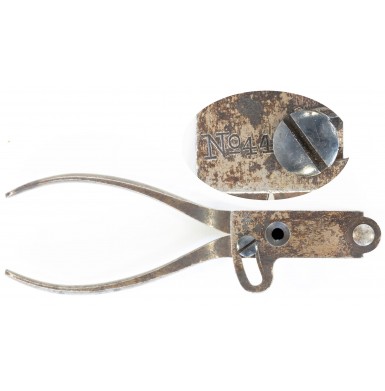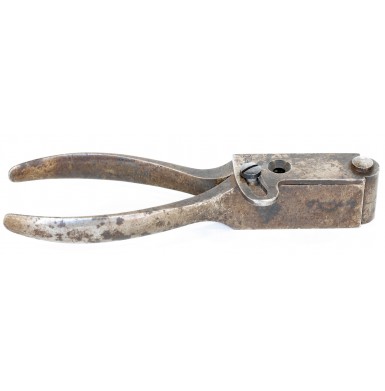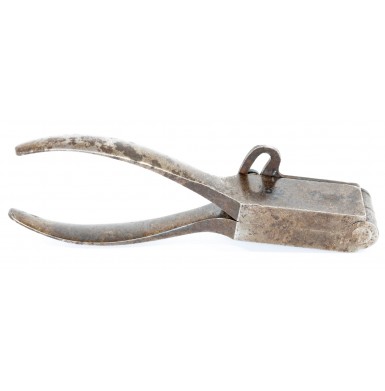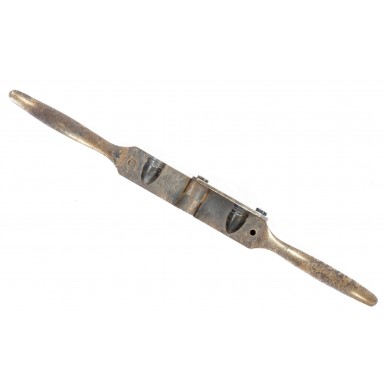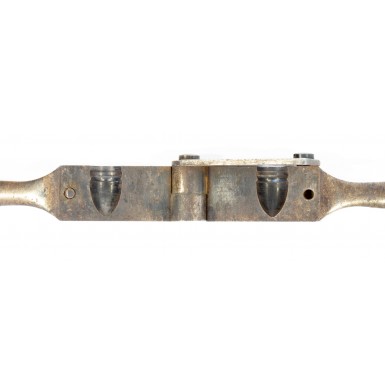This is VERY GOOD+ to NEAR FINE condition example of a fairly scarce mold for the Freeman Army Revolver. The Freeman Army revolver is a fairly scarce Civil War era secondary martial revolver that was contracted for by the US Ordnance Department but was never actually delivered. The story is somewhat complex and, in the end, only about 2,000 were produced and none were delivered under the contract. As such, the accompanying molds for the revolvers are fairly scarce.
On December 9, 1862, Austin T. Freeman received US Patent #37,091 for an “Improvement in Revolving Fire Arms”, most specifically an innovation in the method by which a cylinder arbor pin secured the cylinder to the frame and the method by which the cylinder could be removed from the frame. His design utilized a short arbor pin that had a wing shaped extension on the front and a rounded rear. The pin passed through the cylinder and engaged an arbor in the center rear of the frame and the wing catch at the front of the pin was retained by a spring located on the frame. A small slot in the frame made it possible for the wing to pulled forward after the catch spring was released, enough so the rear of the pin was free of the frame, thus allowing the cylinder to be removed from the frame. Freeman’s patent illustrated a double action percussion revolver, with the cylinder removed from the left side of the frame. While the production version of the Freeman gun was single action and the cylinder was removed from the right side of the frame, it was for all practical purposes irrelevant, as the patent only covered the arbor pin and latch system concept, and Freeman used that design in his production model.
Austin T. Freeman had been born in New Hampshire in 1838 and his early life is not well-known to researchers. By 1860 Freeman was living in German Flatts, NY, in Herkimer County. German Flatts is immediately adjacent to Ilion, NY, where the Remington factory was located. It is possible that during this period Freeman was a Remington employee, and we will see that after the Civil War, Freeman did have an association with Remington. By 1861, Freeman had relocated roughly 100 miles to the southwest to the town of Binghamton, NY where he was employed at the Starr Arms factory. Freeman must have developed the concept for his cylinder arbor system at this time and must have also developed a relationship with Hoard family, as Pitt Hoard and S. Floyd Hoard were the witnesses to his patent application. It appears that “S. Floyd Hoard” was Samuel F. Hoard, brother of Charles B. Hoard. The Hoard family operated a steam engine manufactory in Watertown, NY (about 140 miles north of Binghamton) and with the coming of the Civil War, they used their political connections to secure a government contract to produce US Model 1861 Rifle Muskets. Charles B. Hoard had established the Hoard Armory in Watertown in 1861, and after a number of petitions to the War Department and the endorsements of at least two-dozen members of Congress, Hoard received his first rifle musket contract on December 24, 1861, to deliver 50,000 muskets at $20.00 each. The terms of the contract required the first 1,000 arms to be delivered in July of 1862, with an additional 1,000 in August and September, and with deliveries to be 2,000 per month in October and November of 1862, and 3,000 per month from that point on, until the contract was satisfied. By May 31 of 1862 Hoard had invested some $300,000 in machinery and tooling to produce the rifle muskets, was anticipating spending at least another $75,000, and had yet to deliver a single musket. At this time, the Holt-Owens Commission, which had been established to look into the various arms contracts and the contractors’ abilities (or inabilities) to meet their obligations, had offered to confirm half of Hoard’s original 50,000 musket contract at the original price of $20 each, but also intended to reduce the payments for the second half of the contract (25,000 arms) to $16 each! Hoard reluctantly accepted the new terms, as he was already so heavily invested in the project that he could not afford to terminate the contract. However, as July neared and it was clear that no rifle muskets would be produced and delivered per the terms of the contract, Hoard managed to renegotiate his deal to be a half-sized contract of 25,000 stands of arms, at the original price of $20 each, with deliveries to begin in May of 1863 with a lot of 4,000 guns, and to continue at that rate until the contract was completed. This gave Hoard some breathing room and nearly another year to get his arms manufactory up and running. One of the two signers of the surety bond that protected the government from Hoard defaulting on the deal was Pitt Hoard, who had also been a witness to Austin T. Freeman’s patent application. As with nearly all US rifle muskets contracts during the Civil War, Hoard failed to make deliveries per the terms of his contract. May 1863 came and went, and it was not until October 16, 1863, that Hoard delivered his first 500 stands of arms, of which only 468 were accepted as “1st Class” at the full $20, with the balance of 32 being rated as “2nd Class” and paid for at the lower rate of $19.90. Hoard delivered another 500 guns the next day, all “1st Class,” and managed to deliver a total of 2,000 (half of what was due in May 1863) by the end of that year. Amazingly, after his complete failure to meet the delivery terms of the contact, Hoard received a second contract for 20,000 arms on December 1, 1863; after only delivering 1,500 guns that year, of which only 1,427 were “1st Class! By the end of the war, Hoard would only manage to deliver a total of 12,800 of the 45,000 rifle muskets that he was contracted to produce.
During this same time that Hoard was trying desperately to get his manufactory up and running, he approached General Ripley at the Ordnance Department, offering to produce Freeman’s patent revolvers. His initial letter dated February 16, 1863, offered to manufacture 5,000 of the revolvers at $11 each. Ripley replied on April 14, accepting the offer, but Hoard replied that the price quoted was in error, and the actual unit price would be $12 each. Again, Ripley agreed and on May 30, 1863, the contract was signed, requiring the revolvers to be produced and delivered by September of that year. As with the original rifle musket contracts, Hoard defaulted, and no revolvers were produced or delivered in 1863. In February of 1864 Hoard approached General George Ramsay at the Ordnance Department about a contract extension. Ramsey had replaced Ripley in September of 1863, and he flatly denied the request, citing the fact that not even a sample revolver had been delivered. At this point it appears that Hoard’s political connections came into play, because at the end of February Ramsey contacted Hoard, asking when the pistols might be delivered if the contract was extended. Apparently, Hoard said the right things to Ramsey and on April 8, 1864, the contract was renewed, with delivery of the 5,000 guns to be completed by the end of that year. In late May 1864, Ramsey again contacted Hoard, requesting that two sample revolvers be sent to Colonel William Anderson Thornton at the Ordnance Department for evaluation and noted that the revolvers should be “interchangeable with Remington,” a stipulation that had not been included in the contract previously. Both the sample revolvers were rejected by Thornton for “defects in workmanship and materials used,” but more than likely the real issue was the new requirement that the Freeman/Hoard revolvers be interchangeable with Remington New Model Army revolvers.
Two more samples were requested, but none were forthcoming from Hoard, and the contract expired in late December of 1864 without any deliveries being made. In light of the obvious failure of Hoard to make deliveries, the Ordnance Department had entered a contract on November 29, 1864, with Rogers & Spencer for 5,000 of their revolvers to replace the 5,000 Freeman’s that Hoard was unable to deliver. It is quite possible that this contract is what has created the myth that the Freeman Army revolver was the direct predecessor to the Rogers & Spencer revolver. While the guns do have a very similar silhouette, the primary feature of the Freeman; his patented cylinder arbor pin system, was not used in the Rogers & Spencer. While at least one reference suggests that Hoard produced the sample Rogers & Spencer revolver, this seems quite unlikely, as the manufactory had been unable to produce the Freeman revolvers in time to comply with the contract terms. Further, the Rogers & Spencer was an evolution of the Pettengill revolver, and Rogers & Spencer had sent their sample guns to the Ordnance Department during the summer of 1864, likely right after the Freeman samples were rejected. While some references suggest that Rogers & Spencer bought out the Freeman contract, there is no indication of this, and rather it seems simply a coincidence that the Ordnance Department simply reassigned the contract to a firm that made a revolver that resembled the Freeman design. In the end, it appears that Hoard finally managed to manufacture about 2,000 Freeman Army Revolvers prior to entering receivership at the end of the Civil War.
In the end, Hoard’s original complaint to the Holt-Owen Commission that the contract price offered to produce the rifle muskets was not one at which a manufacturer could make a profit, combined with his limited and delinquent deliveries, conspired to put him out of business. It could also be argued that the time, effort, and expenditures put forth to get the Freeman Army revolver into production only hindered the manufacture of rifle muskets, which had he managed to deliver more of, just might have saved the Hoard Armory. As it was, the approximately 2,000 Freeman Army revolvers that were produced became part of the assets of the defunct company. It is unclear if any of the revolvers were ever sold privately or to any states prior to the end of the war. However, an interesting anecdote regarding their disposition is related by John D. McAulay in his book Civil War Pistols of the Union. In the book McAulay notes that apparently the unsold Freeman Army revolvers were stored in kegs in the attic of the factory carriage house and the son of one of the receivers of the company was known to offer the guns for sale in the Watertown public square for $0.25 each!
The receivers managed to return the former Hoard factory to the successful steam engine business that it had been prior to the war. Austin Freeman returned to his old stomping grounds in Herkimer County, taking up residence in the town of Herkimer and possibly working for Remington again. In 1872, Freeman received two more US patents for improvements to firearms, which he subsequently assigned to Remington. Freeman then moved on to be a short lived, and rather unsuccessful innkeeper, running the Waverly Hotel in Herkimer, until it was repossessed by its former owners in 1878. After this he disappears from the historical record. I am indebted to John D. McAulay’s research, and his book listed above for assistance in telling the rather interesting story of Austin T. Freeman and his Army revolver that was produced for American Civil War service, which it likely never saw.
Like any contract for revolvers during the Civil War era, the US Ordnance Department requested spare parts, gun tools and bullet molds be delivered with the guns. This is one of the scarce Freeman Army Bullet Molds. It is a blued iron mold with a single .44 caliber cavity that casts a conical bullet with a single grease groove and a small tail to facilitate its attachment to paper, foil, or skin cartridges. The mold measures 5 1/8” in overall length with a 2” long mold block that is ¾” wide and 5/8” tall. The mold has bowed integral iron arms and sprue cutter. The mold halves of the mold block are secured by a domed rivet, which also anchors the sprue cutter, which has its travel limited by a fire blued screw. The mold is unmarked other than with the marking No 44 on the top of the sprue cutter, near the travel stop screw. The molds were originally blued when they were produced. I am indebted to noted award winning Civil War revolver collector Mark Anaballi for his assistance in identifying this somewhat obscure bullet mold.
As noted, the mold remains in about VERY GOOD+ to NEAR FINE. The retains only some minute traces of finish on its exterior but does retain some nice blue on the interior of the mold block. The exterior of the mold has a mostly mottled and lightly oxidized pewter gray patina with darker traces of faded blue and widely distributed brown surface oxidation. The mold is very crisp, and the exterior metal is mostly smooth with only a couple of small patches of minor surface roughness but without any pitting to speak of. The crisp single cavity on the inside of the mold casts a conical bullet that is nominally .444” in diameter at the widest point, about .66” in length, and with a very short, .42” diameter tail. The cavity is certainly crisp enough to cast quality bullets today.
For any collector of Civil War era bullet molds, this is a rarely encountered mold that is not often identified, that would be a fine addition to their collection. For a collector of Civil War handguns, it would be a fine accessory to add to that collection. It would display very nicely with your equally scarce Freeman Army Revolver.


